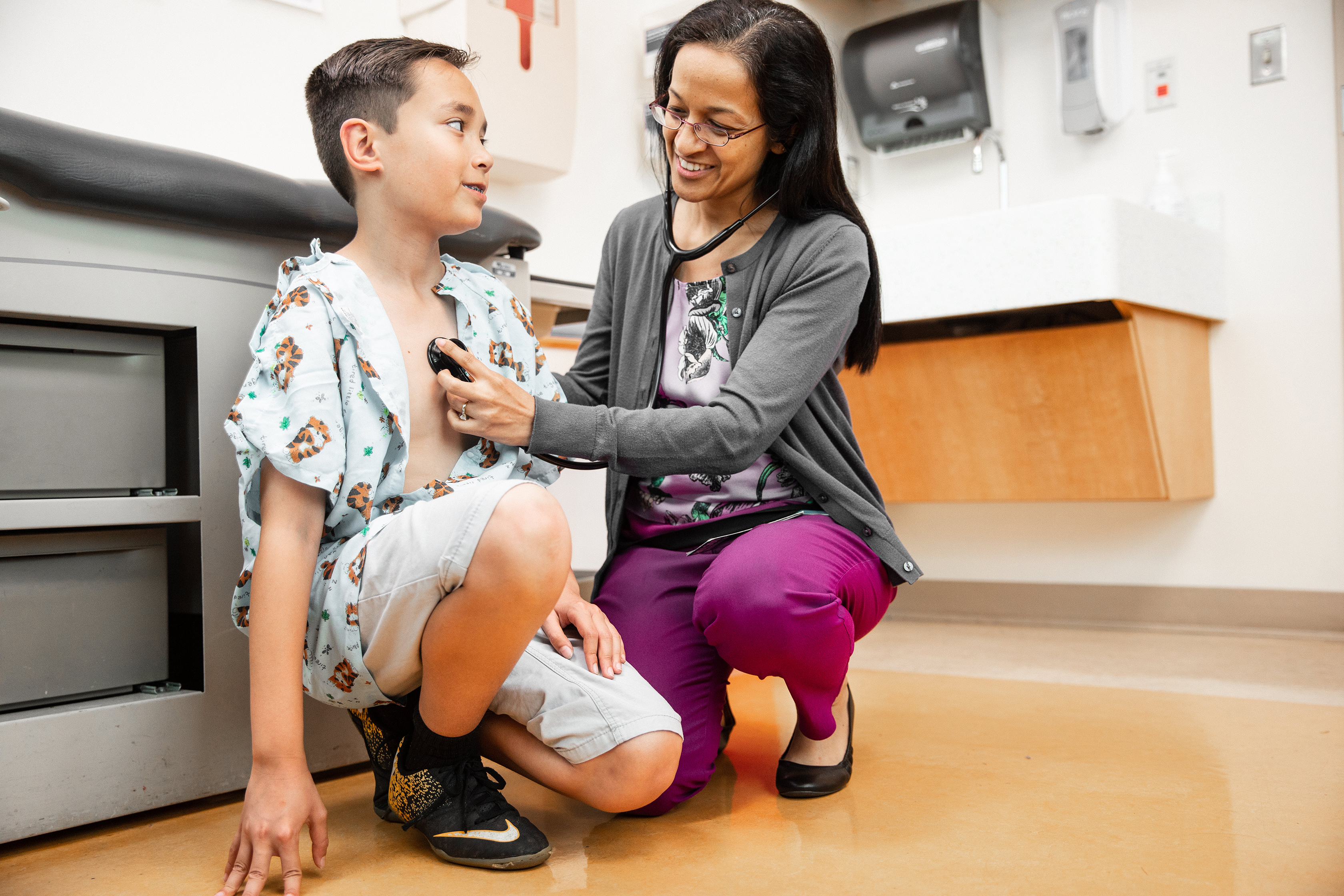Condition
Pediatric Celiac Disease
What You Need to Know
Celiac disease is a digestive problem that hurts your small intestine. It stops your body from taking in nutrients from food.
Key Symptoms
The symptoms of celiac disease vary greatly among patients. Common symptoms include:
- Diarrhea
- Abdominal pain
- Growth problems
- Itchy rash on skin (Dermatitis Herpetiformis)
Diagnosis
Doctors diagnose celiac disease by:
- Blood test
- Endoscopy
- Biopsy
Treatment
- The only treatment for celiac disease is to stop eating gluten
Schedule an Appointment
Our pediatric specialists provide personalized care for your child’s physical, mental and emotional health needs. Meet our providers and schedule an appointment today.
Frequently Asked Questions
What is celiac disease?
Celiac disease is a genetic, autoimmune digestive disease that damages the small intestine and interferes with the absorption of nutrients from food. About one in 100 people has celiac disease, making it one of the most common conditions in children.
People who have celiac disease are permanently intolerant to gluten, a protein found in all forms of wheat, rye and barley. Although the common belief is that gluten is found only in foods, the protein is actually used in many everyday products including medications, vitamins and cosmetic products such as lotion, shampoo and lipstick.
What are the symptoms of celiac disease in children?
The symptoms of celiac disease vary greatly among patients and can affect almost any part of the body. One child may experience severe diarrhea and abdominal pain while another may have skin, liver, neurological, dental or other problems. Many children with celiac disease will have problems with growth.
The most common typical and atypical celiac disease symptoms include:
Autoimmune
- Type 1 Diabetes
- Hypothyroidism (including Hashimoto’s Disease)
- Hyperthyroidism (including Graves' Disease)
- Secondary Hyperparathyroidism
- Sjogren’s Syndrome
- Addison’s Disease
- Autoimmune Liver Disease
- Dilated (congestive) Cardiomyopathy – inflammation of heart muscle
- Alopecia Areata – patchy hair loss
- Rheumatoid Arthritis
- Fibromyalgia
- Collagen-Vascular Disease
- Aphthous stomatitis – canker sores
- Multiple Sclerosis
- Systemic Lupus Erythematosus
- Reynaud’s Syndrome – constriction of blood vessels of hands, feet, fingers and toes
Behavioral/Psychiatric
- Depression – bulk of serotonin found in the intestine, not the brain
- ADD/ADHD/Autism Spectrum Disorder (although no studies have shown a definitive link between celiac disease and ADD/ADHD/autism, many families feel their children have improved on a gluten-free diet)
- Hypochondria
- Inability to concentrate, “brain fog”
- Anxiety
- Neurosis
- Moodiness
- OCD – Obsessive-Compulsive Disorder
Cancers
- Small Intestine Adenocarcinoma
- Lymphoma
- Non-Hodgkin’s Lymphoma
- Melanoma
- Childhood Malignancies
- Thyroid
- Esophageal Carcinoma
Dermatologic and Mucous Membranes
- Dermatitis Herpetiformis
- Eczema
- Psoriasis
- Vitiligo
- Acne
- Rosacea
- Urticaria – hives
- Vasculitis – inflammation of blood vessels
Gastrointestinal
- Diarrhea
- Lactose Intolerance
- Abdominal Distention
- Wasting
- Change in appetite
- Colitis
- Constipation
- Dyspepsia – “stomach aches”
- Bacterial overgrowth
- Malabsorption
- Flatulence
- Reflux/heartburn
- Hepatitis – elevated liver functions
- Pain and bloating
- Ulcers – mouth, esophageal, stomach, upper small intestine
- Vomiting
- CD can be confused with Irritable Bowel Syndrome (IBS), Inflammatory Bowel Disease (IBD), ulcerative colitis and Crohn’s Disease
Hematologic
- Leukopenia – low white blood cell count
- Anemia – iron, folate, B12 deficiency
- Bruising
- Vitamin K deficiency
- Bleeding
- Thrombocytosis – elevated platelet count
- Thrombocytopenia – low platelet count
Neurological
- Peripheral Neuropathies, including Paresthesias – abnormality of sensation; numbness, burning, prickling, itching and/or tingling of hands and feet
- Paraplegia – inability to use legs due to severe neuropathy
- Ataxia – balance disturbance
- Seizures
- Migraines/headaches
- Brain Atrophy and Dementia
Nutritional
- Weight loss
- Stunted growth
- Poor weight gain, “failure to thrive”
- Obesity
- Low blood sugar
Renal
- IgA Nephropathy
Reproductive
- Premature menopause
- Infertility
- Abnormal menstrual cycles
- Spontaneous miscarriage
- Delayed puberty
Respiratory
- Respiratory problems
- Asthma
Skeletal
- Osteoporosis/Osteopenia
- Joint, Bone, Muscle Pain
- Dental Enamel Defects – white or brown spots, ridges on teeth or malformed teeth resulting from typical CD while teeth are forming
- Clubbing – tips of toes and fingers become wide and thick; nails are shiny and abnormally curved
Other Symptoms
- Edema
- Tetany – spasms of hands and feet; muscle cramps
- Fatigue
- Chronic Fatigue Syndrome
- Swelling and inflammation
- Night Blindness
- Chronic infections
- Little or no nail growth
A patient with celiac disease may experience fairly immediate problems such as abdominal pain, bloating or diarrhea after eating gluten-containing foods. However, if the patient continues to eat gluten-containing foods, long-term side effects, such as poor growth, can occur.
How is celiac disease diagnosed in children?
Two types of testing are used to diagnose celiac disease.
The first is a blood test to measure whether there are antibodies (immunoglobulins) to injury, caused by gluten, are in the blood. A person with celiac disease has higher than normal levels of these antibodies in their blood. Antibodies are proteins produced by the immune system in response to substances that the body perceives to be foreign or threatening. For people with celiac disease, the gluten protein is the foreign substance that will cause production of antibodies.
To screen for celiac disease using a blood test, physicians will usually measure levels of:
- Immunoglobulin A (IgA)
- IgA anti-tissue transglutaminase antibodies (anti-tTG IgA)
- IgA anti-endomysial antibodies (EMA IgA)
The screening blood antibody tests are very helpful, but false positive and false negative results can occur. If a person has a positive screening blood antibody test, an experienced healthcare provider will recommend performing a procedure called an endoscopy with a small intestinal biopsy. This procedure is safe, common and quick and should always be performed by an experienced pediatric gastroenterologist.
Almost all children will have the endoscopy and biopsies done under anesthesia, which will guarantee that they will neither feel nor remember the procedure. The endoscope is a thin, flexible tube with a built-in camera system that allows the doctor to see inside the body. The endoscope slides over the tongue, down the esophagus and into the stomach and then the intestine. Using the endoscope, tiny pieces of the intestine are removed to check for damage.
Sometimes a genetic test is done for celiac disease. This test will determine the presence of two genes, HLA-DQ2 and DQ8, which are present in most people with celiac disease and absent in most people who do not have the disease. However, the genetic test cannot give a final answer about whether a person has celiac disease. A positive test is found in about 30-40% of the US population but only about 1% of the population will develop the disease. A negative test makes it very unlikely that a person has celiac disease but does not completely rule it out.
A person must be eating gluten to be tested for celiac disease. If a person stops eating foods with gluten before being tested, the body will stop producing the antibodies that are associated with the injury from gluten. The results of either the screening blood tests or endoscopy with biopsies may be falsely negative.
Who should be tested for celiac disease?
Celiac disease is a hereditary condition, which means it is passed through families. If one family member has the disease, other family members, especially first-degree relatives, should always be tested. First-degree relatives are considered parents, brothers and sisters, or the children of people who have been diagnosed. If a person has celiac disease, approximately 5 - 15% of his/her first-degree relatives will also have the disease.
In families uncertain of their celiac tendencies, it is recommended to test those who have certain chronic conditions and difficult-to-diagnose symptoms.
How is celiac disease in children treated?
The only treatment for celiac disease is a lifelong gluten-free diet, which means eliminating all forms of wheat, rye, and barley. For some patients with celiac disease, starting a gluten-free diet can result in improvement in symptoms in as little as two weeks.
At first, the gluten-free diet can be difficult because gluten is used as a “hidden” ingredient in many processed foods. Recent labeling laws have made it easier to read the labels of food items containing wheat. However, food items containing malt or barley and their derivatives are not covered under those laws so it is very important to carefully read food labels to avoid gluten.
Depending on the child’s age, peer pressure can lead to “cheating,” so it is important to work with a healthcare professional to ensure success. Supportive counseling can help to create proper motivation for parents and children.
What are some foods to avoid for children with celiac disease?
Unlike most diseases, treatment for celiac disease is nutritional and requires the removal of gluten – a protein found in wheat, rye and barley – from the diet. The American Dietetic Association 2006 recommendations for a gluten-free diet are listed below. It is important to check with a healthcare provider before implementing changes to a child’s diet.
Foods to avoid for children with celiac disease:
- Abyssinian hard
- Atta
- Barley grass
- Barley hordeum
- Barley malt
- Bleached flour
- Bran
- Bread flour
- Brewer’s yeast
- Brown flour
- Bulgur
- Bulgur wheat
- Couscous
- Dinkel
- Durum wheat
- Einkorn
- Emmer
- Farina Graham
- Farro
- Fu (dried wheat gluten)
- Germ
- Graham flour
- Granary flour
- Hydrolyzed wheat gluten
- Hydrolyzed wheat protein
- Hydrolyzed wheat starch
- Malt
- Malt extract
- Malt syrup
- Malt flavoring
- Malt vinegar
- Mir
- Miso
- Modified wheat starch
- Pearl barley
- Rye
- Rye flavoring
- Seitan
- Semolina
- Spelt
- Sprouted wheat or barley
- Tabbouleh
- Triticum vulgare
- Vital wheat gluten
- Wheat bran
- Wheat germ
- Wheat protein
- Wheat grass
- Wheatberries
What foods are allowed for children with celiac disease?
Unlike most diseases, treatment for celiac disease is nutritional and requires the removal of gluten – a protein found in wheat, rye and barley – from the diet. The American Dietetic Association 2006 recommendations for a gluten-free diet are listed below. It is important to check with a healthcare provider before implementing changes to a child’s diet.
Foods allowed for children with celiac disease:
- Acacia Gum
- Acorn Flour
- Adipic Acid
- Adzuki Bean
- Acacia Gum
- Agar
- Alfalfa
- Algae
- Algin
- Alginate
- Allicin
- Almond nut
- Aluminum
- Amaranth
- Annatto
- Annatto color
- Apple cider vinegar
- Arabic gum
- Arborio Rice
- Arrowroot
- Artichokes
- Artificial flavors
- Aspartame
- Ascorbic acid
- Baker’s yeast
- Balsamic vinegar
- Bean Flours
- Benzoic acid
- Besan
- BHA
- BHT
- Beta Carotene
- Buckwheat
- Butter
- Calcium carbonate
- Calcium caseinate
- Calcium chloride
- Calrose
- Canola
- Carboxymethylcellulose
- Carnauba wax
- Carob bean
- Carob flour
- Carrageenan
- Casein
- Cassava
- Cellulose
- Cellulose gum
- Cetyl alcohol
- Channa
- Chestnut
- Chickpea
- Citric acid
- Coconut Flour
- Corn
- Corn gluten
- Corn meal
- Corn flour
- Cornstarch
- Corn syrup
- Corn syrup solids
- Corn sweetener
- Cotton seed oil
- Cream of tartar
- Dal
- Dasheen flour
- Desamido Collagen
- Dextrose
- Distilled vinegar
- Enriched rice
- Ethyl maltol
- Ester gum
- Fava bean
- Flax
- Flax seeds
- Folic acid/Folate
- Fructose
- Fumaric acid
- Garbanzo beans
- Gelatin
- Glucose
- Glutamate
- Glutamine
- Glutinous rice
- Glycerol
- Gram flour
- Guar gum
- Herbs (pure)
- Hominy
- Honey
- Hydrolyzed soy protein
- Iodine
- Instant rice
- Invert sugar
- Jasmine Rice
- Karaya gum
- Kasha
- Keratin
- Lactic acid/Lactate
- Lactose
- Lecithin
- Lentils
- Locust bean gum
- Maize
- Malic acid/Malate
- Maltitol
- Maltol
- Maltodextrin
- Manioc
- Mannitol
- Masa
- Masa flour
- Methyl cellulose
- Millet
- Mineral oil
- Mineral salts
- Modified corn starch
- Modified tapioca
- Montina
- MSG
- Mung bean
- Nutritional yeast
- Nuts
- Papain
- Paraffin
- Peanut flour
- Pectin
- Phenylalanine
- Polenta
- Polyethylene
- Polysorbates
- Potassium citrate
- Potassium iodide
- Potassium sorbates
- Potato
- Potato flour
- Potato starch
- Propylene glycol
- Propyl gallate
- Psyllium
- Quinoa
- Ragi
- Rapeseed
- Rice
- Rice flour
- Rice vinegar
- Sago palm
- Sago flour
- Saifun (bean threads)
- Seaweed
- Sesame
- Sesame seeds
- Sorghum Flour
- Sunflower seeds
- Sodium acid
- Sodium benzoate
- Sodium caseinate
- Sodium nitrate
- Sodium phosphate
- Sodium sulfite
- Sorbic acid
- Sorbitol
- Sorghum
- Soy
- Soy lecithin
- Soybeans
- Spices (pure)
- Stearic acid
- Sucralose
- Sucrose
- Sugar
- Sulfites
- Sulfur dioxide
- Sunflower seeds
- Sweet rice flour
- Tallow
- Tapioca
- Tapioca flour
- Tartaric acid
- Tartrazine
- Teff flour
- Teff
- Titanium dioxide
- Tofu
- Turmeric
- Vanilla bean
- Vanilla extract
- Whey
- White vinegar
- Xanthan gum
- Xylitol
- Yam flour
- Yeast
What ingredients are considered questionable for children on a gluten-free diet?
- Beer (all forms are unsafe except those labeled gluten-free)
- Beef/Chicken/Fish/Vegetable Stock (may contain wheat)
- Bouillon (may contain wheat)
- Brewer’s Yeast (depends on whether it’s a by-product of the brewing process [unsafe] or made from sugar beets [safe])
- Dextrin (could be made from wheat, corn, potato, arrowroot, rice or tapioca)
- Fillers (could be wheat, corn, potato or other starch)
- Malted Grains (any grain can be malted. For example, gluten-free beer manufacturers use malted sorghum as an ingredient. This is considered safe. A malted
- grain would be unsafe if the malted ingredient is wheat, rye or barley. If the grain is not specified, it is derived from barley and therefore unsafe)
- Marinades (may contain wheat)
- Miso (may contain barley)
- Mustard Powder (may contain wheat)
- Oats (may be cross-contaminated due to storage and transportation methods)
- Rice Syrup (could be made using barley)
- Soy Sauce/Teriyaki Sauce
- Spices mixes and bulk spices (may contain wheat)
- Yellow Mustard (may contain wheat)
- Yogurt, flavored (may contain dextrin or barley extract)
- Communion wafers (usually contain wheat)
- Dried fruit/roasted nuts (may use wheat in flavoring)
- French fries (may be prepared in shared fryer with wheat products)
- Gravy/sauces (may use wheat as a thickener)
- Instant drink mixes (may contain wheat in flavoring or as bulk)
- Imitation meat/seafood (could be made from wheat gluten or soy)
- Candy (could contain wheat [wafers] or malt. Pay special attention to licorice.)
- Processed meats (may use wheat as a binder)
- Salad dressings (may contain soy sauce or wheat)
- Self-basting turkeys (may contain wheat in broth or bouillon)
- Breakfast cereal (even cereals that are rice- or oat-based may still contain wheat or malt)
- Autolyzed yeast extract (depends on whether it’s a by-product of the brewing process [unsafe] or made from sugar beets [safe])
- Natural flavors (most natural flavors are gluten-free, but there are some that may be made using gluten-containing grains)
- Smoke flavoring (may use barley flour in the production process)
- Cooking spray (some brands use flour to help with non-stick properties)
Meet the Providers Who Treat Celiac Disease
Patient Stories
Departments that Treat Celiac Disease

Bone Health Program
Orthopaedists at Children's National offer world-renowned expertise and life-changing care, including surgery, for children at high risk for bone fracture.

Gastroenterology, Hepatology and Nutrition
Our gastroenterology specialists provide expert diagnosis and treatments for children with digestive, liver and nutrition disorders.

Celiac Disease Program
Working in partnership with concerned members of our community, our Celiac Disease Program and Multidisciplinary Celiac Disease Clinic bring together a team of expert physicians, nurse practitioners, nutritional consultants and psychologists dedicated to developing a national model for detecting and treating celiac disease in children. Learn more about celiac disease care at Children's National Hospital.

Pediatric Aerodigestive Clinic
Our Aerodigestive Clinic provide specialized care for children with airway problems and feeding disorders.

Help Kids and Make a Difference
Invest in future cures for some of life's most devastating diseases. Give today to help more children grow up stronger.










